2023 Annual Report for: Erebidae / Lymantriinae
For species seen in 2023 that had less than or equal to 100 records, full details are included; for more common species, the earliest, latest and highest count by vice-county are shown. The narrative for each species is taken from the main Hantsmoths website, and it is possible that some information on abundance and occurrence can get out of date, as it is impossible to keep up with all changes; however it should give a good introduction to each species. The tables in each species account summarise the previous status, and that for the current year.
For the maps, all records prior to 2023 are shown by a blue dot (the larger the dot, the more recent), with the current year's records shown in red. As previous records are superimposed on any report for 2023, new sites have greater emphasis (i.e. will show as 'more red').
In the species accounts, an asterisk next to a location indicates a new 10km square record; earliest ever dates are highlighted in orange, and latest ever in red. Initials in the species accounts refer to the recorders listed here. Please get in touch if you identify any omissions or errors, in particular if you have records that have yet to be submitted. Details of how to submit records can be found here.
72.009 [B&F: 2031] White Satin Moth Leucoma salicis (Linnaeus, 1758) - Local
Local in plantations, hedgerows, scrub, parks and gardens throughout England. Widespread and locally common in Hampshire, but recorded so far from the Isle of Wight only once this century. Wingspan 43-60 mm. Separated from other large, plain white moths by white abdomen, black and white ringed legs, and silky sheen. Larva feeds on Aspen, Poplar, Sallow and Willow.
Records prior to 2023
| Vice County | #Records | #Individuals | First Record | Last Record |
|---|---|---|---|---|
| 10 | 70 | 112 | 1856 | 2022 |
| 11 | 458 | 493 | 1951 | 2022 |
| 12 | 230 | 264 | 1951 | 2022 |
2023 records
| Vice County | #Records | #Individuals | Max Quantity |
|---|---|---|---|
| 11 | 30 | 34 | 2 |
| 12 | 4 | 4 | 1 |
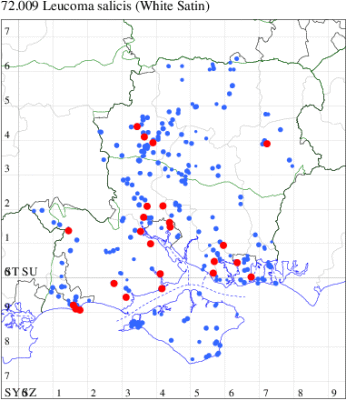
Records by year
Records by week (adult)
Records by week (larval)
Record Details
VC11: Fordingbridge, one, 30 Jun (SCT); Marchwood, one, 24 Jun (CTha); Totton, two, 08 Jul (SSto); Lee, one, 08 Jul (CTha); Romsey, one, 19 Jun; one, 09 Jul (MJB); Needs Ore NNR*, one, 01 Jul (PCra); Swaythling, Southampton, one, 18 Jun (MEdg); Peartree Green LNR, Southampton, two, 07 Jul; one, 21 Jul (MGP); Chandler's Ford, one, 27 Jun (KArb); Lee-on-Solent, one, 28 Jun; one, 04 Jul; one, 07 Jul (IHrg); Fareham, one, male. New for garden. , 20 Jun; one, 22 Jun; one, 02 Jul (ADT); Pigeon House Coppice, Boarhunt, one, 11 Aug; Horsea Island, two, 16 Jun (F.M.G.); Portsmouth, one, 15 Jun; one, 21 Jun; one, 22 Jun; one, 28 Jun (IRT); Hengistbury Head, one, 12 Jun; one, 19 Jun; two, 27 Jun (MJef); Sway, one, 21 Jun; one, 22 Jun (SKee); Pennington, one, 16 Jun (RFC); Needs Ore NNR, one, 16 Jun (CNB);
VC12: Chilbolton, one, 23 Jul (GCE); Anna Valley, Andover, one, 07 Jul; Goodworth Clatford, one, 01 Jul (TJN); Windmill Hill, Chalton, one, 17 Jul (CJP)
72.010 [B&F: 2033] Black Arches Lymantria monacha (Linnaeus, 1758) - Local
Local in woodland, especially of oak throughout southern England and Wales, north to Cheshire; common and widespread in Hampshire and the Isle of Wight. Wingspan male 44-47 mm, female 48-54 mm. Normally unmistakable, but the infrequent f. eremita is entirely sooty grey with cross-lines obscured, and could be mistaken for male Gypsy Moth L. dispar. Larva feeds on Pedunculate and Sessile Oak, causing sufficient damage to be a serious pest in some areas, and over-wintering as an egg.
Records prior to 2023
| Vice County | #Records | #Individuals | First Record | Last Record |
|---|---|---|---|---|
| 10 | 958 | 4129 | 1929 | 2022 |
| 11 | 5755 | 14097 | 1951 | 2022 |
| 12 | 1997 | 7840 | 1951 | 2022 |
2023 records
| Vice County | #Records | #Individuals | Max Quantity |
|---|---|---|---|
| 11 | 342 | 1092 | 44 |
| 12 | 151 | 417 | 43 |

Records by year
Records by week (adult)
Records by week (larval)
Record Summary
VC11: Earliest: Marchwood, 24 Jun, 1 (CTha) Latest: Dibden Purlieu, NF, 04 Oct, 1 (RAC) Max count: Needs Ore NNR, 23 Jul, 44 (CNB)
VC12: Earliest: Great Haughurst Copse, Axmansford, 24 Jun, 3 (ACB) Latest: Selborne, 08 Sep, 2 (CJP) Max count: Great Haughurst Copse, Axmansford, 12 Jul, 43 (ACB)
72.011 [B&F: 2034] Gypsy Moth Lymantria dispar (Linnaeus, 1758) - Naturalised
Formerly frequent in the fens of East Anglia, this moth was presumed extinct in Britain in the early 1900s when breeding sites were cleared and drained. Occasional records, mainly from coastal southern England, since then have been regarded as immigrants. However, in the 21st century it has become temporarily established in a very few areas, these all thought to be accidental introductions by the horticultural trade. In Hampshire there has been a pattern of increased occurrence in the 21st Century, possibly related to radiation out from the introduced colonies in London, and breeding was first evidenced in 2019 when larval webs were discovered in Basingstoke. It is probably resident at low levels in urban areas across the county. Wingspan male 48-53 mm, female 59-65 mm. The male has prominent crescent-shaped black reniform mark and black orbicular spot; the female is superficially similar to female Black Arches - but the latter species is smaller with the female Gypsy Moth having a thickset and blunt abdomen - and cannot fly, rarely travelling far from the cocoon and thus any occurrence in Britain of a female moth is clear evidence of local breeding.
The extinct English race fed on Bog-myrtle (Myrica gale) and Creeping Willow (Salix repens). On mainland Europe occurs in a wide variety of habitats feeding on broadleaved trees and bushes.
Records prior to 2023
| Vice County | #Records | #Individuals | First Record | Last Record |
|---|---|---|---|---|
| 10 | 11 | 10 | 1955 | 2022 |
| 11 | 44 | 295 | 1951 | 2022 |
| 12 | 80 | 99 | 2006 | 2022 |
2023 records
| Vice County | #Records | #Individuals | Max Quantity |
|---|---|---|---|
| 11 | 7 | 7 | 1 |
| 12 | 56 | 104 | 15 |
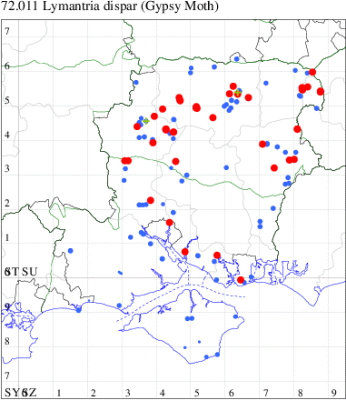
Records by year
Records by week (adult)
Records by week (larval)
Record Details
VC11: Romsey, one, 21 Aug (NRJ); Broughton, one, 22 Aug; one, 22 Aug (GCE); Hamble-le-Rice, one, indoors, 19 Aug (CBarr); Swaythling, Southampton*, one, 21 Aug (MEdg); Fareham, one, 22 Aug (MLO); Southsea, one, field observation, 16 Aug (LBro);
VC12: Chilbolton, two, 14 Aug; two, 21 Aug; two, 31 Aug (GCE); Anna Valley, Andover, two, 07 Aug (TJN); Picket Piece, Andover, one, 02 Sep (JAsl); Littleton, one, 10 Aug; one, 03 Sep; Lower Wyke Farm, St Mary Bourne, one, 01 Sep; Barton Stacey, two, 15 Aug; one, 15 Aug; one, 15 Aug; one, 08 Aug; two, 08 Aug; Cole Henley, one, 24 Aug; one, 24 Aug; one, 24 Aug (GCE); Overton, larva, two, field observation, 26 Jun; larva, one, field observation, 30 Jun (PEH); four, 21 Aug (FTu); one, 19 Aug; one, 22 Aug (ACr); one, 13 Aug (FTu); North Waltham, two, 27 Aug; one, 04 Sep (AJon); Basingstoke, two, 10 Aug; four, 13 Aug; two, 01 Sep; Sherborne St John, four, 16 Aug (MJW); Oakridge, Basingstoke, one, 24 Aug (IFS); Old Basing, present, field observation, 23 Jul (iNat); Alton, two, 08 Aug; one, 10 Aug; one, 16 Aug; one, 27 Aug (DBO); Noar Hill HIWWT NR, Selborne, one, 01 Sep (AMD, FHay det. AMD); Whitehill, one, 17 Aug (ASto); Whitehill, Bordon, one, 29 Jul (DMurr); Farnham*, present, field observation, 19 Aug (iNat); present, 09 Jul (Bird); Fleet Pond, 11, 10 Aug; 15, 17 Aug; one, 03 Sep; larva, four, field observation, tapped from oak when sweeping for H.sericiella, 07 May; one, 22 Aug; one, 03 Aug; three, 23 Aug (MHals); Farnborough, one, 09 Aug; two, 15 Aug; one, 20 Aug; one, 02 Sep (MThmp); Blackwater, one, 21 Aug; two, 22 Aug; one, 24 Aug (BGD); Farnborough, one, field observation, 07 Aug; one, 20 Aug (KBW); one, to a lighted window, 16 Aug (JKni)
72.012 [B&F: 2029] Brown-tail Euproctis chrysorrhoea (Linnaeus, 1758) - Local
Local in scrub, hedgerows, parks and gardens, along the coasts on England from Yorkshire to the Isles of Scilly. In Hampshire and on the Isle of Wight formerly confined to a few coastal localities, notably Hayling Island, this species has recently and suddenly greatly increased its range. Larval nests are now plentiful in winter along the coast, mainly on hawthorn, bramble and blackthorn, and it is extending its range inland. Wingspan male 36-42 mm, female 39-41 mm. Larva feeds on Bramble, Hawthorn, Blackthorn, Dog-rose and Sallow, living gregariously within a silken web, causing sufficient damage to be a serious pest in some areas. The larval hairs are extremely irritating, causing rashes on exposed parts of the skin.
Records prior to 2023
| Vice County | #Records | #Individuals | First Record | Last Record |
|---|---|---|---|---|
| 10 | 692 | 5509 | 1951 | 2022 |
| 11 | 3114 | 9374 | 1951 | 2022 |
| 12 | 241 | 313 | 1951 | 2022 |
2023 records
| Vice County | #Records | #Individuals | Max Quantity |
|---|---|---|---|
| 11 | 120 | 1515 | 750 |
| 12 | 37 | 53 | 4 |
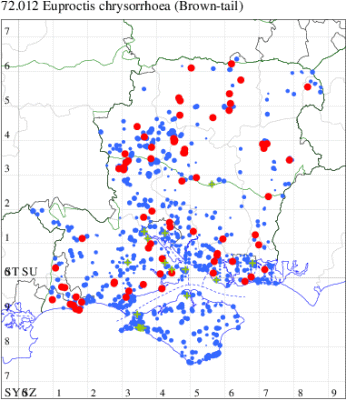
Records by year
Records by week (adult)
Records by week (larval)
Record Summary
VC11: Earliest: Calshot, 04 Apr, 100 (PGS) Latest: Farlington Marshes HIWWT NR, 14 Sep, 10 (NBur) Max count: Calshot, 14 Sep, 750 (PGS)
VC12: Earliest: Whitchurch, 22 Jun, 2 (SuBro) Latest: Leckford Dairy, 15 Aug, 1 (KaHer) Max count: Ecchinswell, 07 Jul, 4 (MJN)
72.013 [B&F: 2030] Yellow-tail Euproctis similis (Fuessly, 1775) - Common
Common in hedgerows, woodland, scrub and gardens throughout England, increasingly also in Scotland. Widespread and common in Hampshire and on the Isle of Wight. Wingspan male 35-42 mm, female 37-45 mm. The main confusion species are Brown-tail E. chrysorrhoea, in which the underside of the abdomen is covered in brown hairs, and White Satin Leucoma salicis which lacks the yellow abdomen of E. similis and has legs ringed black and white. Larva feeds on Hawthorn, Blackthorn, Hazel, Pedunculate and Sessile Oak, Silver and Downy Birch, Sallow and Elm.
Records prior to 2023
| Vice County | #Records | #Individuals | First Record | Last Record |
|---|---|---|---|---|
| 10 | 571 | 1162 | 1951 | 2022 |
| 11 | 4983 | 9407 | 1948 | 2022 |
| 12 | 2497 | 6092 | 1951 | 2022 |
2023 records
| Vice County | #Records | #Individuals | Max Quantity |
|---|---|---|---|
| 11 | 77 | 143 | 9 |
| 12 | 78 | 127 | 10 |
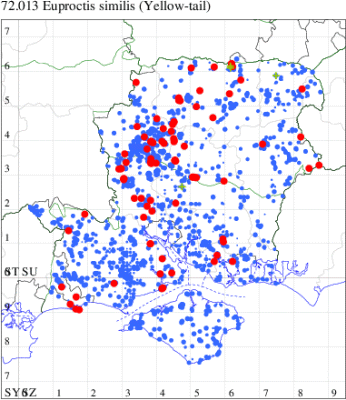
Records by year
Records by week (adult)
Records by week (larval)
Record Summary
VC11: Earliest: Hale Purlieu, NF, 13 May, 1 (JPuz) Latest: Fareham, 09 Sep, 1 (MLO) Max count: Needs Ore NNR, 02 Jul, 9 (PCra)
VC12: Earliest: Littleton, 27 Jun, 1 (GCE) Latest: Axmansford, 27 Sep, 1 (ACB) Max count: Tidgrove Warren, nr Overton, 07 Jul, 10 (MJW, ACB)
72.015 [B&F: 2028] Pale Tussock Calliteara pudibunda (Linnaeus, 1758) - Common
Common in gardens, hedgerows, parks, woodland and scrub throughout England. Widespread and common in Hampshire and on the Isle of Wight. Wingspan male 48-51 mm, female 59-68 mm. Unmistakable. Larva feeds on various broad-leaved trees and shrubs, including Hawthorn, Blackthorn, Crab Apple, Pedunculate and Sessile Oak, Silver and Downy Birch, Hazel, Lime and Elm, over-wintering as a pupa.
Records prior to 2023
| Vice County | #Records | #Individuals | First Record | Last Record |
|---|---|---|---|---|
| 10 | 826 | 1663 | 1977 | 2022 |
| 11 | 4676 | 8222 | 1951 | 2022 |
| 12 | 2345 | 5301 | 1951 | 2022 |
2023 records
| Vice County | #Records | #Individuals | Max Quantity |
|---|---|---|---|
| 11 | 149 | 234 | 11 |
| 12 | 76 | 121 | 6 |

Records by year
Records by week (adult)
Records by week (larval)
Record Summary
VC11: Earliest: Pennington, 29 Apr, 1 (RFC) Latest: Burley New Inclosure, NF, 22 Oct, 0 (iNat) Max count: Upham, 02 Jun, 11 (F.M.G.)
VC12: Earliest: Basingstoke, 04 May, 1 (MJW) Latest: Wellesley Woods, Rushmoor, 25 Oct, 1 (SBly) Max count: Lord's Wood, Pamber Forest, 10 Jun, 6 (MBot)
72.016 [B&F: 2027] Dark Tussock Dicallomera fascelina (Linnaeus, 1758) - Local
Local on heathland, moorland, sand-dunes and shingle beaches, discontinuously in southern and north-western England, and eastern Scotland. In Hampshire local on the heaths of the New Forest, where it appears to have increased, and the north-east, where it is not faring so well; on the Isle of Wight recorded recently only from the Freshwater/Totland area. Wingspan 40-53 mm. Unmistakable. Larva feeds on Heather, Broom, Creeping Willow, Bramble and Hawthorn.
Records prior to 2023
| Vice County | #Records | #Individuals | First Record | Last Record |
|---|---|---|---|---|
| 10 | 5 | 6 | 1972 | 2013 |
| 11 | 242 | 257 | 1951 | 2020 |
| 12 | 14 | 12 | 1951 | 2014 |
2023 records
| Vice County | #Records | #Individuals | Max Quantity |
|---|---|---|---|
| 11 | 1 | 1 | 1 |

Records by year
Records by week (adult)
Records by week (larval)
Record Details
VC11: Ogden's Purlieu, NF, one, 29 Jun (AMD)
72.017 [B&F: 2026] Vapourer Orgyia antiqua (Linnaeus, 1758) - Common
Common in urban gardens and parks, open woodland, fens, hedgerows, heathland and moorland throughout the British Isles. Widespread and common in Hampshire and on the Isle of Wight. Wingspan male 35-38 mm, female wingless. Male day-flying, occasionally coming to light. The main confusion species is Scarce Vapourer O. recens, which differs in having a white subapical spot. Larva feeds on various broad-leaved trees and shrubs, including Birch, Hazel, Sallow, Hawthorn, Blackthorn, Elm, Lime and Oak, over-wintering as an egg.
Records prior to 2023
| Vice County | #Records | #Individuals | First Record | Last Record |
|---|---|---|---|---|
| 10 | 233 | 235 | 1973 | 2022 |
| 11 | 1684 | 1584 | 1947 | 2022 |
| 12 | 796 | 1119 | 1951 | 2022 |
2023 records
| Vice County | #Records | #Individuals | Max Quantity |
|---|---|---|---|
| 11 | 57 | 64 | 6 |
| 12 | 45 | 47 | 2 |
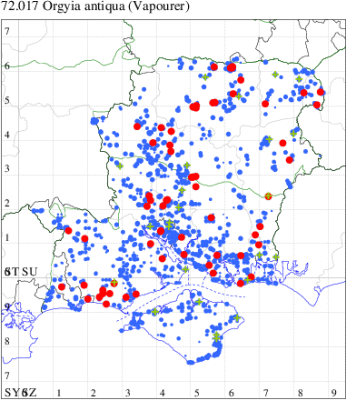
Records by year
Records by week (adult)
Records by week (larval)
Record Summary
VC11: Earliest: Brockenhurst, NF, 29 Jan, 0 (iNat) Latest: Bishop's Waltham, 25 Oct, 1 (DTru) Max count: Portsdown Hill, 09 Oct, 6 (KBW)
VC12: Earliest: Aldershot, 21 Jun, 1 (RDea) Latest: Overton Lagoons, 13 Oct, 1 (PEH) Max count: South Wonston, 08 Sep, 2 (JOug)